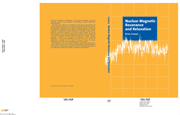Book contents
- Frontmatter
- Contents
- Preface
- 1 Introduction
- 2 Theoretical background
- 3 Detection methods
- 4 Classical view of relaxation
- 5 Quantum treatment of relaxation
- 6 Dipolar lineshape in solids
- 7 Relaxation in liquids
- 8 Some case studies
- 9 The density operator and applications
- 10 NMR imaging
- Appendix A Fourier analysis
- Appendix B Random functions
- Appendix C Interaction picture
- Appendix D Magnetic fields and canonical momentum
- Appendix E Alternative classical treatment of relaxation
- Appendix F Gm(t) for rotationally invariant systems
- Appendix G P(Ω, Ωo, t) for rotational diffusion
- Problems
- References
- Index
Preface
Published online by Cambridge University Press: 02 December 2009
- Frontmatter
- Contents
- Preface
- 1 Introduction
- 2 Theoretical background
- 3 Detection methods
- 4 Classical view of relaxation
- 5 Quantum treatment of relaxation
- 6 Dipolar lineshape in solids
- 7 Relaxation in liquids
- 8 Some case studies
- 9 The density operator and applications
- 10 NMR imaging
- Appendix A Fourier analysis
- Appendix B Random functions
- Appendix C Interaction picture
- Appendix D Magnetic fields and canonical momentum
- Appendix E Alternative classical treatment of relaxation
- Appendix F Gm(t) for rotationally invariant systems
- Appendix G P(Ω, Ωo, t) for rotational diffusion
- Problems
- References
- Index
Summary
This book started as a joint project between Michael Richards and myself. We discussed and planned the work in great detail but somewhere along the way Michael moved away from physics, drawing on his experience at Sussex University, to become a psychotherapist. Notwithstanding the plans we made, his withdrawal from the project has resulted in a book hardly recognisable from that originally envisaged. Since the publication of Anatole Abragam's encyclopaedic treatise on nuclear magnetism in 1961 the field has grown at such a pace that no single book could hope to cover its many aspects. However the coverage of this book is without doubt narrower and its content impoverished as a consequence of Michael's career change.
Mea culpa. I am guilty of the very sin of which I have accused others. The motivation for writing a book on NMR was that the various books available, since Abragam's, did not cover the material which I, my colleagues and research students required. It seemed that the new books comprised assorted collections of topics in NMR. Michael and I wanted to redress this, but in surveying the finished product I see no more than yet another assortment of topics. This time, however, it is my collection of topics. While the broader aim might not have been achieved my hope is that this assortment will have its appeal.
In the preface to Abragam's book in 1960 he wrote that he hoped his book would still be the book on the subject thirty years after its publication. That was prophetic; his wish has been amply fulfilled.
- Type
- Chapter
- Information
- Nuclear Magnetic Resonance and Relaxation , pp. xix - xxivPublisher: Cambridge University PressPrint publication year: 1997

